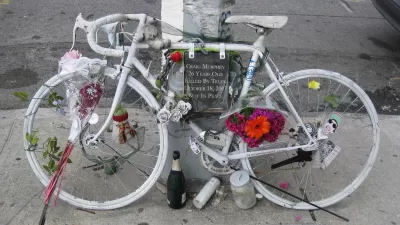Traffic fatalities in California have been rising since 2010, rising to 3,104 in 2013 after decreasing from 2006 to 2010. Experts point to several specific reasons for the increase; one of the most prominent may be in your hand right now.
The economy may seem like the likely cause for the reversal in traffic crashes, particularly with the increase coinciding closely with the end of the Great Recession, but Tony Bizjak, transportation reporter for the The Sacramento Bee, writes that the recovery helps explain the increase in the number of vehicles and vehicle-miles-traveled, but not necessarily fatalities.
In some ways, the connection seems obvious: More people on the roads means more fatal encounters. But state highway officials say that doesn’t have to be the case. Having more cars on the roads doesn’t always lead to more crashes. In some instances, crowded roads can make driving safer by forcing motorists to slow down and pay more attention. (For instance, crash rates on rural roads are higher than on urban streets.)
Distracted driving, a cause célèbre of former U.S. Secretary of Transportation Ray LaHood, seems like another likely reason. But Chris Cochran of the state Office of Traffic Safety, [a division of the California State Transportation Agency] "said it is uncertain how big a role distracted driving plays in crashes because drivers often don’t admit after a crash that they were on their phones rather than watching the road."
Even if motorists were to admit to using their phones, California's laws do not reflect today's technology. The 2007 cell phone law that bans "drivers using hand-held cellphones to talk and text" doesn't account for all the other uses of smart phones, as Cochran explains.
“Before, you could talk or text, and that was it. Now with a half-million apps, people practically run their lives off their cellphones. They check their stocks. They GPS. They play Candy Crush. They are watching movies.”
Is it time for new legislation to address the many uses of smart phones that can result in distracted driving?
A state appellate court last year ruled that a CHP officer was wrong to ticket a Fresno driver for consulting a map on his smartphone. The law also is silent on whether a driver can check Facebook while driving.
Caltrans pointed to another 'lifestyle' trend: "drugged-driving crashes are on the upswing," writes Bizjak. "Some of that may stem from older drivers taking prescription drugs that affect their driving ability. Marijuana use also is likely up, safety officials say."
Also under 'lifestyle' is the increase in motorcycle and bicycle riding, particularly among older males, that has caused an increase in fatalities from prior years.
Whatever the reason, the result is that "(s)ince 2010, the death toll has ticked up annually, hitting 3,104 in 2013," notes Bizjak. That's still lower than 2006, when "4,300 people were killed on roads and highways," but higher than 2010, when 2,739 died. Officials expect the upward trend "to continue when 2014 numbers are finalized."
Hat tip: MTC-ABAG Library
FULL STORY: Traffic deaths climbing in California – Is there a fix?

Depopulation Patterns Get Weird
A recent ranking of “declining” cities heavily features some of the most expensive cities in the country — including New York City and a half-dozen in the San Francisco Bay Area.

California Exodus: Population Drops Below 39 Million
Never mind the 40 million that demographers predicted the Golden State would reach by 2018. The state's population dipped below 39 million to 38.965 million last July, according to Census data released in March, the lowest since 2015.

Chicago to Turn High-Rise Offices into Housing
Four commercial buildings in the Chicago Loop have been approved for redevelopment into housing in a bid to revitalize the city’s downtown post-pandemic.

New Park Opens in the Santa Clarita Valley
The City of Santa Clarita just celebrated the grand opening of its 38th park, the 10.5-acre Skyline Ranch Park.

U.S. Supreme Court: California's Impact Fees May Violate Takings Clause
A California property owner took El Dorado County to state court after paying a traffic impact fee he felt was exorbitant. He lost in trial court, appellate court, and the California Supreme Court denied review. Then the U.S. Supreme Court acted.

How Urban Form Impacts Housing Affordability
The way we design cities affects housing costs differently than you might think.
City of Costa Mesa
Licking County
Barrett Planning Group LLC
HUD's Office of Policy Development and Research
Mpact Transit + Community
HUD's Office of Policy Development and Research
City of Universal City TX
ULI Northwest Arkansas
Town of Zionsville
Urban Design for Planners 1: Software Tools
This six-course series explores essential urban design concepts using open source software and equips planners with the tools they need to participate fully in the urban design process.
Planning for Universal Design
Learn the tools for implementing Universal Design in planning regulations.




















